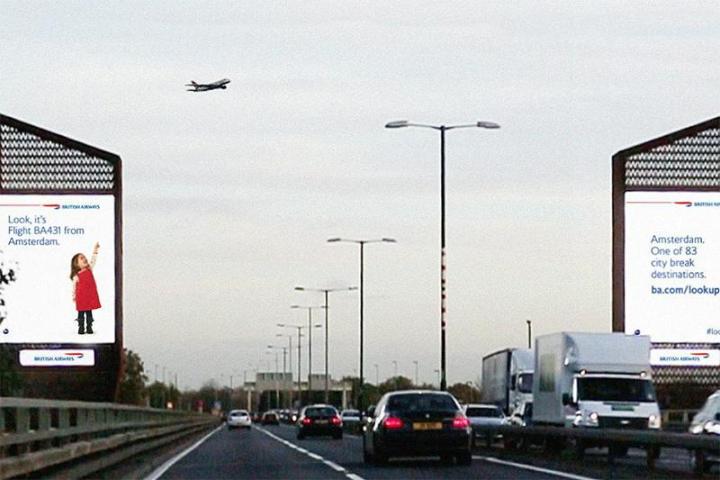
At the tail end of last year British Airways launched a London-based ad campaign that had a child on a giant digital billboard interacting with events in the real world, in this case planes flying overhead on their way into and out of Heathrow airport.
The ad, which cleverly combined a kid’s fascination with flying objects with many an adult’s desire to jump on a jet plane heading to an exotic location, was widely praised for its originality, though at the time its creator, ad agency Ogilvy & Mather London, gave little away as to how it was made, saying simply it’d involved a bit of “digital wizardry” using custom-built surveillance technology.
Over the weekend, however, agency director Jon Andrews threw a little more light on the process, explaining how the idea for the campaign was inspired by his two young children, who, when playing in the yard, would stop whatever they were doing when a plane flew overhead, pointing up at it in “wonder and amazement.”
“To them, planes were magical,” Andrews told Co.Create‘s Rae Ann Fera, adding that the campaign’s aim was to “take people back to that magical moment when they first flew,” with the digital billboard “targeting a very specific, special moment a BA plane flew overhead, capturing people’s imaginations and inspiring them to make a booking.”
Street View search
The team first used Street View to seek out ideal locations for the billboard, which had to be perfectly situated in relation to the flight path and have the right viewing angles, too.
After months of research, two locations were chosen: one bang in the center of London at Piccadilly Circus, and the other in Chiswick, close to Heathrow airport.
“I prototyped the idea on my phone, so when I was out and about at each location, I could hold it up to the sky and pretend to be the billboard,” Andrews told Co.Create. “Further down the line, we also created a mobile app to position our ‘trigger zone’ perfectly in the sky. This allowed us to perfectly time each billboards’ reaction to each plane and make sure the ad tracked it perfectly across the sky.”
Aircraft info
He goes on to say how his team used an ADS-B (automatic dependent surveillance – broadcast) antenna to read planes’ transponder data within 125 miles, which provided information on their location, speed, altitude and call-sign.
“We created a virtual ‘tripwire’ in the sky, triggering our billboards to display our ads every time a British Airways plane flew overhead,” Andrews said, adding that that it was important to know the exact position of the aircraft, “because if our ad triggered even a fraction of a second early or too late, the children would be pointing at a clear sky instead of a plane – massive fail!”
When a plane passed overhead, the aircraft’s flight number and point of origin showed up on the billboard, at the same time revealing pricing information for its country of departure.
Cloud sensors
A neat touch was the incorporation of cloud-height sensors in the billboards, so if they detected that it was too cloudy to see the planes, the system would pause until more suitable weather prevailed.
According to Andrews, British Airways’ campaign ended up becoming the most talked about piece of airline advertising in 2013. It’s certainly a great example of how an off-beat idea can take a campaign to another level, with the high-tech billboards going viral as people around the world scratched their head and asked, “So, how did they do that?”


